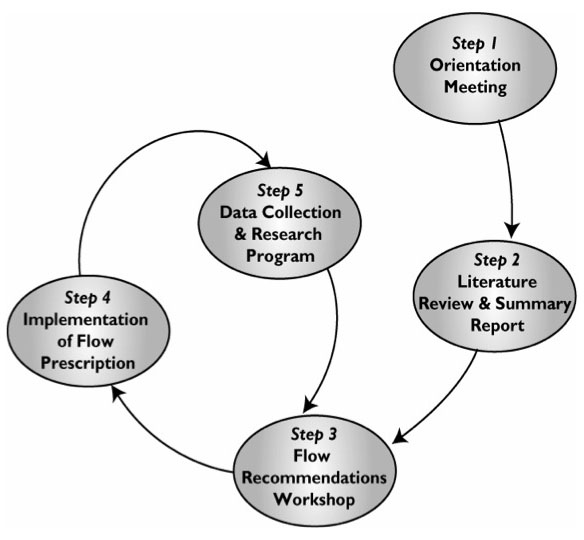The Nature Conservancy’s adaptive, interdisciplinary, and science-based approach to site-specific environmental flow assessment, implementation and adaptive management has been applied in a range of contexts around the world. Because it was first demonstrated and described for the Savannah River in Georgia, USA (Richter et al, 2006), it has acquired the nickname, the “Savannah” process. Similar to the Downstream Response to Imposed Flow Transformation (DRIFT) method (King et al, 2003) and the Building Block Methodology (BBM) (King and Louw, 1998), the Savannah process is considered holistic because it addresses the linkages between a full range of flow characteristics and diverse ecosystem components. All three of these holistic methods rely heavily on facilitated expert consensus to prescribe environmental flows.
The figure below illustrates the Savannah process.

Adaptive Management of Environmental Flow Restoration in the Savannah River describes the application of these three steps to the Savannah River, Georgia, USA
Step 1 is a one-day orientation meeting. The purpose of the orientation meeting is to inform and engage interested parties – including scientists, water managers, government agencies and other stakeholders – in the process of prescribing environmental flows and provide a forum for them to express their values and concerns for the river. The meeting begins with an overview of the proposed process. During breakout sessions, participants discuss the details of the process, identify additional scientists who should be involved and identify sources of information that can inform the process.
Step 2 is the preparation of a literature review and summary report describing existing data and knowledge of the river-floodplain-estuary system, native species and their flow dependencies. The primary purpose is to describe qualitatively the annual and inter-annual flow patterns needed to restore or sustain ecosystem health. During this step, the Indicators of Hydrologic Alteration (IHA) software may be used to analyze the current hydrology of the river compared to the pre-development hydrology. Typically, this report is contracted to an interdisciplinary academic team. Richter et al (2006) describe the basic structure of the report in detail, noting that it is helpful to organize information about life stages and ecological functions according to specific environmental flow components.
The following reports illustrate the outcome of Step 2:
Step 3 is a facilitated expert workshop, which typically runs about two days. The workshop participants should be highly interdisciplinary, representing expertise in all riverine ecosystem components. During this workshop, scientists are tasked with developing a set of flow recommendations, also known as an environmental flow prescription. To the extent possible, scientists are encouraged to articulate these recommendations quantitatively, describing recommended ranges of flows throughout the year in terms of magnitude, duration, frequency, timing and rate of change. The flow recommendations can be provided in the form of Environmental Flow Components (EFCs), such as low flows, high-flow pulses and floods, and recommendations can vary between dry, average and wet years. Initial recommendations generally are developed within breakout groups, each focusing on a major portion of the river (e.g., confined river vs. floodplain river) or major groups of organisms (e.g., fish vs. riparian vegetation). Each breakout group prepares and justifies flow recommendations for its area of emphasis. Next, workshop participants are re-organized into new breakout groups focused on different EFCs (e.g., low flows vs. floods and high-flow pulses). Finally, the whole group reconvenes to develop a unified environmental flow prescription and prioritize future research needs to fill data gaps. The following flow workshop reports illustrate outcomes of Step 3:
Step 4 is the initial implementation of the flow prescription. Following the flow workshop, scientists continue a dialogue with water managers to identify opportunities for implementing portions of the recommendations. Often, sufficient management flexibility exists to begin implementing some of the recommendations immediately, in the form of flow experiments. These provide a valuable opportunity for improving scientific understanding of the flow conditions necessary to effect desired ecological changes or processes. Therefore, monitoring of both flow changes and ecological response are critical at this stage. By carefully tracking the response of an ecosystem to flow management, the flow prescriptions can be further refined, thus helping to ensure that river management accomplishes its objectives. While some recommendations can be implemented or tested relatively quickly, other recommendations may require further modeling or research to reduce physical, economic or political uncertainties. The following report documents an outcome of Step 4:
Step 5 is additional data collection and research as needed to refine the environmental flow prescription. Konrad (2010) examined monitoring data collected for this purpose at five different sites where the Savannah process is being applied.
